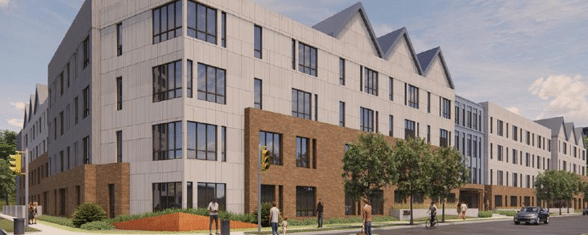From Concept to Capital: Inside the Deal That Will Break Ground on ‘The Square’

By Abram Mamet
11 min read
🔉 Editor’s Note: You can enjoy a recording of the full panel here.
Exploring the possibilities of a new deal can be daunting, as a dizzying number of choices face affordable housing developers. These choices can be critical, no matter how seemingly minor, as they can save or add millions of dollars to a deal’s total development cost.
Fortunately, developers can take those deals to one of the many National Housing & Rehabilitation Association (NH&RA) conferences that happen each year around the country, and workshop its specifics with the deep pool of experts in attendance. At the recent NH&RA Summer Institute in Boulder, CO, one panel (“The Bond Market and Housing Affordability: Strategies for Success”) did just that, with a developer presenting a unique LIHTC deal to a panel consisting of an underwriter, a bond lawyer, and a lender to discuss the decisions that may be most beneficial for the project.

The developer was Corey Stark, vice president of finance and development at Birge & Held.
Stark’s deal is “complicated, and he’s been spending a few years trying to find enough subsidy to make it feasible,” said moderator James D. Spound, president of R4 Capital Funding. “At this point, he’s getting close, and he’s now coming to his friends in the industry for our best structuring advice and recommendations.”
In particular, the group focused on the bond financing structure, a topic as dense as it is vital for a project’s viability. “One of the critical decisions that Corey needs to make, maybe six to eight months out from executing his project, is what financing path he wants to follow,” Spound said.

Although several nuanced decisions surround bond financing structures—such as public offerings vs. private placements—a recently popularized tool known as the “cash-collateralized bond structure” captured much of the day’s discussion.
Traditionally, bond deals take a “construction-through-perm” structure, in which debt is taken on all at once and becomes permanent financing. However, under a cash-collateralized structure, the initial financing period—occurring during construction and ending once a project is ready to be placed into service—goes through a much more complicated structure that unlocks some additional earnings.
Various factors will influence the ultimate structural decision, including the interest rate environment for both short- and long-term yields, as well as the specific market in which the development will operate.
The Deal
The deal in question is Lila on the Square, a component of the sprawling billion-dollar redevelopment of northwest Indianapolis’s Lafayette Square Mall. “Lila on the Square is going to be the first shovel in the ground of what is to be about a billion-dollar redevelopment,” said Stark.

In 2008, the mall began to decline and has since closed, changing hands multiple times. The current owner is an Argentinian immigrant who grew up in the area. “This is his home; it’s unique to his heart,” Stark said. “He’s had a lot of success in the retail side of real estate and put an opportunity zone fund together and purchased the entire plot.”
To be called “The Square,” the 115-acre redevelopment will feature residential, local retail, childcare, schooling, and sports facilities. “The owner knows that affordability of housing is going to be key, and that’s why this is the first project in the overall development,” Stark said
Total development cost is $46.2 million. A relatively straightforward six-component capital stack included Federal Low Income Housing Tax Credit equity, state tax credits, HOME funding, and dollars from a local affordable development initiative. There were negligible land costs, as the building will utilize a ground lease structure within the Opportunity Zone Fund. Additionally, Stark pointed to solar as one critical bridge to help get the project to pencil. Typically, solar will add three to seven percent of a project’s total development cost as a gap filler, simply based on the projected utility savings. For this deal, “it’s five to six percent,” Stark said. “That’s how we bridged the final gap.”
Of course, another major funding component for the transaction came from debt via the bond structure, which Stark said will provide nearly half ($20.4 million) of the project’s total financing package.
Understanding Your Interest Rate Environment
After Stark presented the deal, Brad Edgar, managing director at Stifel, was tasked with discussing the factors that may influence Stark’s decisions around bond financing.

Critical to these decisions about bond finance structure is interest rates, Edgar said – the primary tool that influences the cost of borrowing. In recent years, that environment has been volatile, and only just exited “a painful period” of sustained interest rate hikes, which Edgar said he is “glad to have behind us.”
Rates are generally set as a “target,” and can differ based on the terms of the loan or bond. Typically, short-term bonds mature in one to five years and will have lower rates than long-term bonds. These short-term bonds can offer benefits for projects. “A lot of our financing structures will issue short-term bonds,” explained Edgar. “We’ll try to invest those bond proceeds in U.S. Treasuries. Over the last three years, we’ve had what we call positive arbitrage. That’s where we can issue short-term bonds at a rate of interest that’s less than what we can turn around and invest those bond proceeds in. That creates positive earnings. Today, that’s anywhere from 50 to 65 basis points. Often, our developer clients can keep that positive earnings, or some of that positive earnings. Sometimes you do have to rebate that back to the federal government—it really depends on the bond structure and on the bond counsel.”
Occasionally, short-term rates can actually be higher than long-term rates, creating a unique phenomenon called an “inverted yield curve,” which often signals a weaker economy and can have negative impacts on project financing. Until recently, the U.S. Treasury yield curve was inverted; today, Edgar said, “we’re in what I would consider to be a flat yield environment, where there’s not a whole lot of difference between short-term rates and long-term rates.”
The panelists emphasized that it is essential to understand not only current interest rates but also possible interest rate scenarios in the future, going so far as to run financial predictions based on an array of potential interest rate environments. “Nobody has a crystal ball, but you’ll be happier if you make a decision based on your view of what the world is going to look like in four to six months,” said Spound.
The Allure of the Cash-Collateralized Structure
Once a developer has a comfortable understanding of the interest rate environment and anticipates being in during construction, they can decide how to structure their bond proceeds, said Spound.
“At this point, there are two main branches” facing Stark’s project. On one side, Spound said, is the “more traditional” construction-through-perm structure. “Our firm does it in a private placement manner, where it’s one source of capital. We are the construction lender, tax-exempt, and then there’s a stabilization or conversion, and it becomes permanent, 17- or 18-year financing.”
The alternative, Spound detailed, is the cash-collateralized structure, in which a project’s bonds would be sold by a broker and escrowed during the construction period. While escrowed, those funds would themselves be invested, offsetting the interest and “becoming a source of capital for the transaction.”
In a cash collateralized deal, there is a separate “traditional construction lender, which is typically a bank,” said Spound. That lender makes a taxable construction loan, which then undergoes a typical draw-down structure, where debt is funded as loan advances are made. (This is opposite “fully funded” deals, where the entire amount of publicly offered bonds is taken at once, causing what is called negative arbitrage). Draw-down funding can save up to two to four percent in savings, depending on the state of the yield curve, according to an April analysis done by Wade Norris, Esq. (founding partner at Norris George & Ostrow PLLC) and published by NH&RA.
Though draw-down structures exist in traditional loans, “there are no earnings on interest, because you’re just drawing down proceeds and putting them into the deal,” said Spound. In a cash-collateralized structure, proceeds are reinvested “into a termed, Treasury-type investment.”
These structures typically last throughout the construction period of a project, which is usually over 36 months.
If executed correctly, cash-collateralized bond packages can provide significant additional earnings. Spound pointed to one deal where, due to the factors of the rate environment, the project earned an additional $2.5 million during the 36-month period in which the cash collateralized structure was in place.

However, cash-collateralized structures are significantly more complicated and involve the separate issuance of the secondary construction loan. This can cause pain points on the legal side. “This is much more lawyer-intensive,” said Andrew P. Schmutz, partner at Kutak Rock. “It does drive up the costs, and it takes a lot of effort, because you’re really documenting two transactions.”
Thus, Spound emphasizes that extra earnings must be worth it. Otherwise, the juice may not be worth the squeeze. “You’ve got another bond counsel, you’ve got an underwriter, you’ve got rating fees,” he said. “Because the structure is more complex, attorneys may charge more, bond counsel may charge more, developer’s counsel may charge more.”
Additionally, this extra equity translates to increased income, which can have significant tax implications. “Somebody has to take that income,” Spound cautioned. “If you (as the developer) takes that income, typically your syndicator or your direct investor will look at you and say, ‘either you take the income and your taxes are your problem, or we’ll take the income into our fund, but in order to stay yield-neutral, we’ll take a penny or two off the price of your equity.”
Spound pointed to a workaround, which involves partnering with a tax-exempt organization, such as a housing finance corporation or another nonprofit entity. “That solves the problem, typically, as you can allocate the income to a non-tax-paying member of the development partnership.”
For Stark, this calculation is essentially a risk-assessment exercise, and one that increasingly points towards cash-collateralized structures as the better option. “Let’s get as much capital into the deal, because if something doesn’t go as planned, it’s a lot easier to solve that problem when you have more capital in the deal than it is when you have less,” he said. With that in mind, Stark said it is generally worth the extra hours that it takes his partners to manage the transaction. “We all work for the deal. And that’s how we make that decision.”
Effects of the 25 Percent Test on Bond Finance Structures
In July, a major shift hit the LIHTC industry when the bond financing threshold was reduced from 50 to 25 percent, halving the proportion of municipally issued tax-exempt bonds required for a deal to be eligible for four percent LIHTCs.
While the total effects of the new “25 percent test” will take time to assess, the panelists predicted that this change would impact how developers choose to structure their bond proceeds, as fewer of those bonds will be tax-exempt. “On the debt side, the mix of tax-exempt to taxable proceeds will change, particularly during construction,” said Spound.
Spound also highlighted that, since cash collateralized structures favor tax-exempt bonds, they may become less impactful in an environment where there are small tax-exempt pieces. “You would have less income earnings on the reinvestment of those proceeds, and you would have less of a basis boost from the expenses.”
“And you have it on the other side, too,” added Stark. “A higher portion of your construction financing will now be taxable. Accordingly, you’re going to have a higher interest rate carry through your deal. So, if it’s a typical $50 million deal with $35 million of construction financing, you’re probably looking at anywhere from $10 to $15 million more of taxable capital.” This adds about $500,000 to $750,000 more in interest carry. “That’s not nothing on one of those deals,” he said, noting that this additional tax liability substantially eats into the gap filler he is gaining with his inclusion of solar.
“Still,” Spound said, “it will probably be OK. But there’ll be less enthusiasm about the opportunity.”

